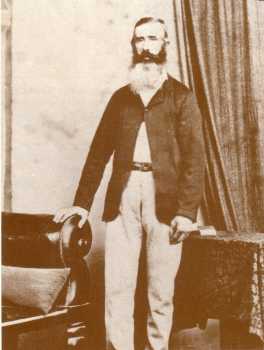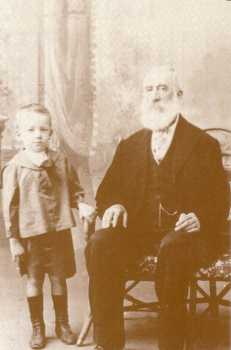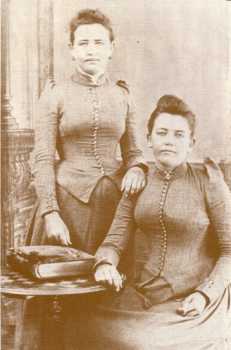Probable Usefulness
Chapter 3
With thanks to the O'Connor family for the following Chapters
From Leighlin Bridge in Carlow
When Englishmen set to work
to wipe the tear
Out of Ireland's eye,
they always buy
The pocket handkerchief
at Ireland's expense. - Saunders.
Memories of 1798 were still recent enough to be vivid in Carlow when Mary Murphy was born 16 August 1829 and when Patrick Francis Moran (later Cardinal), was born 16 September 1830, both in the township of Leighlin Bridge about eight miles south of the city of Carlow, and on the Barrow River. The people of Carlow were deeply moved by the sufferings of their fellow men. Patrick Moran's mother, Alicia (alias Mary) Cullen, had three uncles executed for their part in the '98 Rising and her father, Hugh Cullen of Craan, Leighlin, was tried for his life and barely escaped hanging. Her grandfather, Patrick Maher, was imprisoned four times for refusing to pay tithes. When her brother Paul Cullen (later Cardinal) was ready for College his father sent him to Carlow College saying, 'No son of mine will take the King's money for his education', referring to the Government subsidy paid to Maynooth. Carlow College refused to ask for a license from the local Protestant Bishop as required by law, so no subsidy was paid to it. Carlow College was opened in 1793 entirely at the expense of the Catholic community, to give the Catholic boys the chance of a good Catholic education and also an opportunity to study for the priesthood since the Irish seminaries in France had been closed by the French revolution.

Patrick Murphy
Patrick Murphy and his wife, Margaret Doyle of Leighlin Bridge, were among the more fortunate peasants or farmers, who had survived the potato famine of 1846-7, with their children. Mary born 1829 and Patrick born 1831 were old enough to share in the work. Ellen born 1835, Catherine 1838 and Bridget 1840 were of school age, so that Anne born 1845 was the only really young one to be especially cared for. They were sufficiently close to the town for the children to attend school and so receive a good basic education. Thus it was that Mary and Ellen had the stamp of 'Probable Usefulness' on their emigration papers when, in 1853 they answered Caroline Chisholm's plea and advice for `good women' to go to Australia, not only to relieve the distress and starvation in Ireland but also to help the struggling men to build a new homeland, a new country and a new society in Australia.
Mary packed, as her greatest treasures, her Bible and her dictionary. These were to be her lifelong companions and greatest helps. With them she gave her children the beginning of a good education so that they rose to serve their country, the country that had given Mary a new start in life, in so many ways.
Towards the end of July, 1853, the 'Caroline' sailed from England with Mary and Ellen on board. The two women busied themselves at once with helping to care for children on board and proved so helpful that they each found themselves with permanent employment before they even reached Australia

Patrick Murphy and his grand-nephew, Arthur Vincent Smith (c.1911)
Rough and stormy seas were causing much concern in Brisbane, (Moreton Bay) during the first few days of November, 1853, when a group of Blacks from Cleveland arrived in the city on the afternoon of Wednesday, 2 November with a story of an immigrant ship run aground and in great danger at the south entrance to Moreton Bay.
There was great anxiety lest it should be the 'Caroline' the departure of which vessel for Sydney was believed to have taken place in July, though what could have brought her to the south entrance was a mystery. The schooner 'Raven' was chartered by Mr. Watson, agent of the expected 'Caroline', to proceed to the scene of the disaster on Friday morning. However the return of Mr. Sheridan of the Customs Department, late on Thursday night, dissipated the greater anxiety, for unfortunate as had been the loss of the 'Countess of Derby', there was no loss of life and it was not nearly as tragic as would have been the loss of the 'Caroline' with more than three hundred immigrants on board. The 'Countess of Derby' was on its way to load wool and other produce at Cleveland. The 'Caroline' sailed majestically into the Bay on Monday morning 7 November 1853 quite unaware of the drama and anxiety of the previous week. The passengers for Ipswich were transferred to the river boat for the final short stage of their journey.

Margaret and Mary Farrelly - twin daughters of Bridget Murphy and Frederick Farrelly
When the family for whom Mary had been working on board, moved into their new home in Ipswich, Mary went with them. It was to this home then that John Connor paid a visit and Mary would claim, in later years, that the moment this tall, strong, handsome man stepped on the verandah she felt within herself, 'That is my man' So from that time her story becomes one with his.
After the pleasant and interesting accounts that Mary and Ellen Murphy sent home of their new life in this new land, their brother Patrick, and younger sisters, Bridget, Catherine and Anne, came to Ipswich about 1863-64.
They quickly found work and made friends in the district. In 1865 Catherine married William Smith, Anne married Denis Dillon Martin and about the same time Bridget married Edward Farrelly, all in Ipswich.
Catherine and William Smith had only two sons, one of whom died in infancy and William Charles was still very young when his father died. Catherine married again in 1884 to William Sexton.
Bridget and Edward Farrelly had two sons, Bernard and Francis, and four daughters, Anne, Margaret and Mary - twins - and Eva.
Anne and Denis Martin had three sons, Patrick, Michael and Denis, and four daughters, Mary, Agnes, Margaret and Theresa. Denis was only seven years old when his mother died, 11 April 1887.
After his wife, Ann Murphy, died in Ipswich in 1887, Denis Martin sold up his home and went to Charters Towers in 1889. His eldest daughter, Mary Ellen, and his two youngest children. Theresa and Denis, went with him, also his brother-in-law, Patrick Murphy. They lived in Milchester area of Charters Towers and Patrick Murphy found work on the railway line which was at that time being built from Townsville to Mt. Isa. Perhaps Denis Martin worked on it too, or he may have worked in the gold mines. In 1899 Theresa Martin married Thomas Graham in Charters Towers. Thomas worked on cattle stations and their first home was at 'Hedden Valley,' west of Bowen and near the Burdekin River. Then they moved further north in the Georgetown area. They had two daughters and five sons. Their oldest daughter, Kathleen, and her third brother, John, are now living in the family home 'Montrose,'Wyandra, near Charleville, Queensland (1984).
Chapter 4 →
Contact Peter O'Connor mailto:oconnorpr@optusnet.com.au for more O'Connor family details
↑
